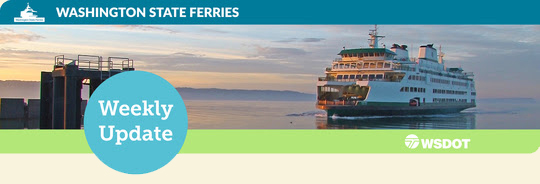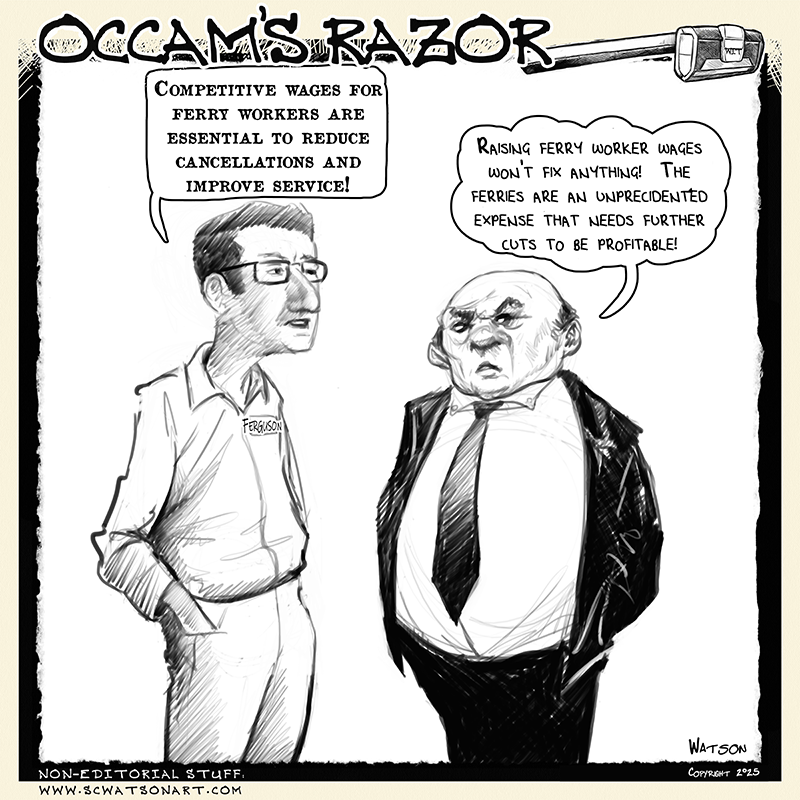— by Emma Heikkinen, Orcas Issues Summer Intern —
The Eastsound Planning and Review Committee (EPRC) met for a three-hour session on July 6 from 3-6 p.m. at the Eastsound Fire Station to discuss the Subarea Plan Work Group recommendations, which will be used to create a comprehensive survey. Other policy changes and proposals were discussed, as well.
County Council Update
- Councilman Rick Hughes updated the committee on the county discussion. Discussion — which was held in a meeting in Friday Harbor in the morning of July 6 — included safety improvements in terms of the proposed propane tank business, a promising connector road to allow a direct route for oil, and the land bank infrastructure affordable housing project.
- On July 11, from 11:30 a.m. to 2 p.m., the head of ferries will be present at the Orcas ferry terminal’s formal ribbon-cutting ceremony for their recently completed work. An overall rejuvenation of the Orcas Village Landing is in the works, with more dock space, a kayak finger dock, an ADA-accessible park, and beach access.
- Tolling plans, gas tax, and the state’s plans to increase revenue to maintain the road systems will be discussed with an independent group from the state’s Department of Transportation on July 10 in Friday Harbor.
- Washington State Parks plans to conduct a visitor survey among those who are boarding boats in order to determine intent for their comprehensive study on population. The county hopes to determine visitors’ intent for visiting, and to determine current island capacity. “We have to build capacity to match whatever our demand is,” stated Hughes. “Once we get our teeth around numbers, density, things like that, the comprehensive plan will move faster.”
- Hughes asked the committee for feedback on lighting, and to create a plan that can be proposed to the county. Hughes asked the Chamber and EPRC to “actually do something” about providing direction, and clarified that he was not asking the committee to “play politics,” but to provide a plan.
Public Access/Comment #1
Fred Klein stated his interest in seeing the EPRC focus on Mt. Baker Farm, citing the “pastoral views” with “Mt. Baker in the distance.” With a new owner of the property focusing on a low-impact business, Klein stated that the property — if fully successful — will bode well for the community’s interests. Should the business come under pressure, said Klein, there is a potential for development in areas of the land that had been subdivided. Klein proposed a conservation easement on a parcel of the land in order to incentivize development.
Klein said “I personally believe that EPRC can take initiative on a local issue like this. This is a really important issue with time limits.”
Marlia Starwater restated that the Crescent Beach road turn needs lighting, as part of a safety concern.
Main Topics:
- Subarea Plan Work Group Recommendations
Discussion surrounded the topic of how to integrate individual work group’s recommendations for the Subarea Plan, how to determine the conflicts, and determine the gaps.
EPRC board member Margaret Payne suggested the groups get together for a final vetting, including ranking; she proposed each group meet alone and then as a whole. EPRC board member Bob Maynard commented that the groups should “get on with it.” Paul Kamin stated that “we should be sensitive to asked time” of volunteers, and that asking for more meetings is difficult. He stressed the importance of timeliness in this decision, and the public vetting process should occur soon (“put pedal to the metal”).
Maynard restated that the committee “needs to do something,” and that the “commonalities are great” but there is a need to get the ideas out to the public “quickly.”
[perfectpullquote align=”right” cite=”” link=”” color=”#778899″ class=”” size=””]“People want experiences, not to buy something.”[/perfectpullquote]
Kamin suggested four categories for the Subarea Plan: 1. capital improvement, 2. code changes, 3. smaller-scale projects, and 4. enforcement.
A two-week timeline was set for organizing each work group’s recommendations, with EPRC Chair Jeff Otis as the clearinghouse.
EPRC board member Dan Vekved brought up the trail planning document created by Parks. The document included responses from an estimated 16% of over 1200 islanders, and contained questions asking which activities enjoyed by islanders and where such activities are enjoyed. Walking “came up huge,” stated Payne.
Community Development Director Erika Shook stated that what would be most helpful in the Subarea Plan Work Group recommendations were the groups’ highest priorities and proposals for payment for the projects. She emphasized the limited number of ways for which projects can be funded — including grants, higher taxation, donors, and developers — and hoped the work groups could figure out potential sources of funding.
Payne stated “when we do our categorizing and ranking” that capital issues would be addressed.
Payne brought up her concerns surrounding the future economic feasibility of some projects. “We need to be very futurist here,” she stated, in regards to energy usage, sustainability, and the economy of Orcas in the face of internet services such as Amazon. She recalled asking the Chamber “what kind of businesses do you foresee the community needing,” to which the Chamber responded “people want experiences, not to buy something.” As such, Payne questioned the economic viability of some project proposals.
Kamin stated “we have a mountain of stuff on the table only half done … economic viability is not a priority of any of the groups we worked with.”
New EPRC board member Yonatan Aldort said “I agree with what Paul’s saying. We could potentially address some of these gaps with the survey. Whatever response the public gives should be used to see what’s feasible.”
[perfectpullquote align=”right” cite=”” link=”” color=”#778899″ class=”” size=””]“We have a mountain of stuff on the table only half done.”[/perfectpullquote]
Payne reiterated that the economy affects the density of Orcas, and that she isn’t convinced that Orcas needs “tons of commercial spaces.”
- Survey Proposal — https://sanjuanco.com/DocumentCenter/View/12493 presentation by survey group
The survey group members stated that they were unsure of adding economy issues to the survey, due to the lack of group effort put into organizing issues surrounding the economy, unlike the other work groups. They reminded the committee of the “vast involvement” put into the work groups, and that “mixing” developed and undeveloped topics “seems unstable;” that the economy and sustainability are integral to all of these projects, and thus groups should identify the importance of sustainability as it relates to the forthcoming recommendations.
Hughes said that “we’re looking for input,” and while certain questions may be weighed differently, the opportunity to understand what the community is saying remains important.
Aldort said that some groups did address economy and sustainability, and thus were not as undeveloped as suggested.
Conversation shifted to the presentation of the questions in the survey. Payne suggested a format of survey presentation that “addressed issues,” including phrasing questions by including potential future issues with proposals at hand. It was suggested that such phrasing could be biased. “Are you in favor of investing sums of money in infrastructure that’s going to be washed out in ten years?” was given as an example of a biased question. “Also a factual,” commented Payne.
Board members discussed issues in regard to “getting the most” from the survey. Otis said that he would like to see what the public thinks of the work group recommendations in a particular ranking. Aldort asked the survey group what they envision in terms of the scope of the survey. The group hopes to disseminate the survey to the largest group as possible.
Otis hopes for the survey to be “short and concise” in terms of keeping community interest. [Patty] encouraged the EPRC to work on PR and notices in the future to help generate interest in “investing in the community” by participating in the survey.
Public comment opened for the survey group. Clarification was given in regards to demographics; the survey will be given to both full- and part-time residents, and to all of Orcas, although the focus is on Eastsound planning. Demographic questions will be asked at the beginning of the survey. A question was raised regarding a potential skew towards the full-time community due to the survey’s launch in September.
The survey will be shared with the community without names, and statistical foci, interpretations, and summarization can be completed by individual community members. “I want to see the raw data,” said Hughes.
- Prioritizing recommendations
The committee raised the issue of single-family Eastsound residences not needing to conform to design standards, a loophole in the residential code. Hughes emphasized the EPRC’s need to vote on prioritization, which the committee took as a cue to vote on changing the loophole. “I just want a vote with a recommendation to council on doing stuff,” he stated in regard to the EPRC’s proposals surrounding subarea plans.
A movement to “set the design standards to apply to all within the village commercial and village residential district,” including single-family residents, was proposed. Kamin said “I absolutely love this motion,” but questioned its necessity at this meeting.
Payne said that the EPRC is torn between inaction and action, and recalled the “criticism and comments” that “we [the committee] don’t get a whole lot done.”
Vekved said “I fully support the recommendation,” and that the loophole is a “flaw in the design standards.” “Everybody needs to conform.” Maynard added,“we don’t really do anything. We talk about it.” Hughes intervened with “don’t take me too literal. I was asking for recommendations for everything, not one single change in the subarea plan.” He requested a list of code changes, not just one word. Public weigh-in of a code change may be necessary, he noted.
Otis proposed a withdrawal of the motion, which Aldort seconded. The motion was withdrawn.
Bob Maynard presented two ideas:
- To implement a tax credit for residents who provide rental homes to county employees, and to provide a tax advantage for bike paths created on private properties.
- To create a shuttle bus system from the ferry landing to Eastsound using funds from the lodging tax; the system would change the summer impact of guests in the lessening of cars on roads. The system would have to be “free, fun, frequent,” summarized Maynard.
“That’s my suggestion, for whatever the hell it’s worth, Mr. Chairman,” closed Maynard.
Payne and Kamin presented their update on their grant application for paths along Lovers Lane and Enchanted Forest Road, with a quick presentation on the scope of the project. Economic benefits, safety issues, and connecting the waterfront to the business district were advantages provided. Public Works are the co-sponsors for the project.
Public comment opened on the Lovers Lane and Enchanted Forest Road path proposal. Issues raised focused on utilization. Existing trails are in the areas described, but are not clearly marked.
Lodging Tax Presentation
Paul Kamin presented his study of San Juan County’s lodging tax. He found that post-2011, a significant growth in tax revenue can be found from Orcas alone. Orcas Island is the largest contributor to the county’s total lodging tax revenue of all the islands.
From 2011-2016, revenue has gone from $800,000 to $1.4 million. Grants, too, have grown, but not as much. Hughes stated that the difference between grant allocation and tax revenue is due to a grant reserve created due to past funding issues.
[perfectpullquote align=”right” cite=”” link=”” color=”#778899″ class=”” size=””] Orcas Island is the largest contributor to the county’s total lodging tax revenue of all the islands. [/perfectpullquote]
Kamin suggests a larger percentage of grant revenue come to Orcas, and that there is opportunity for Orcas funding. Lodging tax grants go to applicants that go through the grant process, the Chamber of Commerce, the SJ Visitors Bureau, and promotional tourism material.
Other
Erika Shook reviewed the proposed amendments for vacation rentals, which has been presented at other meetings. The vacation rental ordinance will increase enforceability and clarity, and introduce permit expiration and visitor safety concerns.
Kamin updated the committee on the meeting which took place the evening of July 5 regarding the proposed 30,000 gallon propane tank business. Over 40 people were in attendance, voicing concerns regarding property value and safety. Kamin stated that the “co-owner answered questions with empathy,” and emphasized the safety factors built into the facility. A potential incident could block residents’ evacuation due to the dead-end of the street, and the fire chief acknowledged the substantive challenge of managing an evacuation if necessary — a 1.375 mile evacuation would be required.
On July 13 public comments regarding the proposed facility will be sent to the hearing examiner. Impact to public welfare is a chance for denial.
Public Access/Comment #2
Fred Klein re-stated the necessity for EPRC intervention at Mt. Baker Farm, and the closing window of opportunity. Otis requested for Klein to “spearhead” the effort with the help of two other EPRC members. Furthermore, he requested that the Eastsound Subarea Plan close a small lot parking requirement that was the result of “sloppy code language” created 25 years ago; the language has a “phenomenally negative effect” on development, and the EPRC needs to take action.
**If you are reading theOrcasonian for free, thank your fellow islanders. If you would like to support theOrcasonian CLICK HERE to set your modestly-priced, voluntary subscription. Otherwise, no worries; we’re happy to share with you.**








Thank you to Emma Heikkinen for this informative reporting .
I actually find this entertaining.. EPRC, which has a long history.. seems to follow Countys recommendations…
I would like to give one illustration though..
When I decided to build a Home and two out buildings in the rim of Eastsound I submitting permits to SJ county as such.. I was told I could not build them as I had designed. The roof pitch was questionable.. I was told, approach EPRC, which I did.. and they said, we don’t have a problem with this.. then I reapproched the County with the same questions.. which they said.. we don’t have a problem with this..
my point is simple, we can transparently create rules that even the newest individual to the island should be able to comprehend.
My only grace was I spent the time to ask and try and get an understanding of the why.. years later I spent a few years on that same committee..
I’m still wondering why.. I get the common values of our village being protected.. but I’m not sure of from what??
I can say for the most part, I do appreciate the character of diversity created by our citizens of past and present. It’s a true canvas of our community.
The charm of Eastsound is why this one individual continues to spend energy and capital, because I appreciate the wonderful culture we share on this tiny Rock.